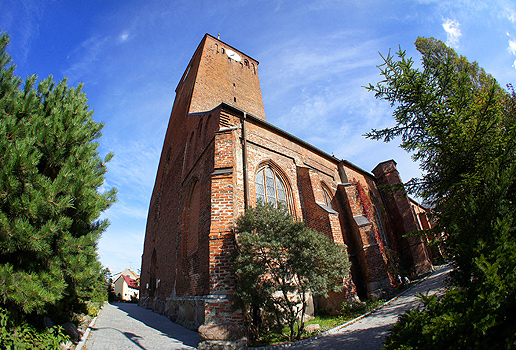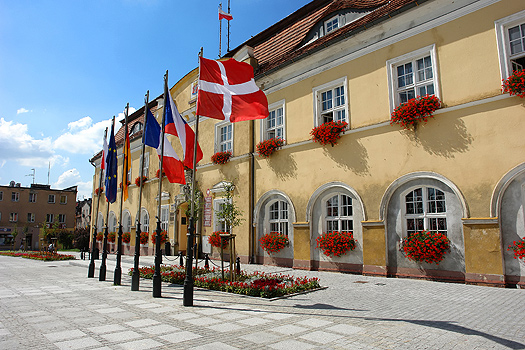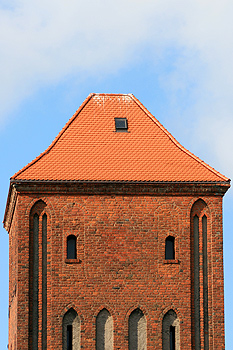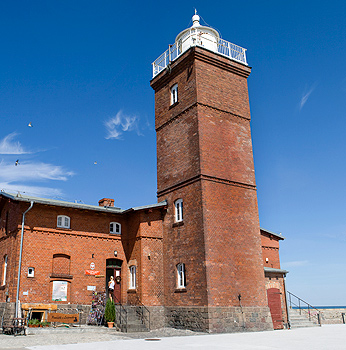 |
||
|
Worth seeing
THE CASTLE OF KING ERIC
Although documents directly relating to the construction of the castle in Darłowo have not been found yet, the results of archaeological and architectural and historical premises allow us to date back the creation of the castle to the second half of the fourteenth century. It was during the reign of the prince of the House of Griffins, Boguslaw V and Elizabeth, the daughter of King Casimir the Great. The prince purchased the island with a mill in 1352 from a rich burgher of Darłowo - Elizabeth von Behr - in order to build a fortress on it. Over the decades, a castle had grown on the island, which in its main outlines has survived to this day. The work of Boguslaw V was at that time so representative that so that as early as in 1372 a congress of the Pomeranian princes - brothers and cousins Boguslaw took place within its walls. The first sovereign, who modernized the defense system and extended the castle was Prince Eric the Pomeranian. It took place in the years 1449 to 1459, when after the loss of the throne of Scandinavia, the dethroned king returned to his legacy. An old king was accompanied by a beautiful and young servant-maid Cecilia, who was the love of his life. Historians still argue about who this mysterious woman really was. Some of them maintain that in the last years of his life, reaching his seventies – she became his wife. One of the contemporary chronicles mention her as "the queen Cecilia". Shrouded in mystery, the history of the great love of King Eric and Cecilia became an inspiration for artists. The poem "The Return of the Prince Eric" was created by a poet and writer of Koszalin - Czeslaw Zea, and an American journalist and writer Lucie Lehmann - Barclay has been penetrating the archives of Denmark, Sweden, Norway, Germany and the UK for several years in search of traces of Cecilia and Eric. The aim of the writer is to create a love novel of this unique pair based on historical facts. The initial appearance of a medieval fortress of Darłowo was an inspiration to build a similar but larger Kronborg Castle by King Erik in Denmark, where after years, William Shakespeare placed the action of "Hamlet". The castle of Darłowo is also associated with the figure of Eric Pomerania’s granddaughter - Princess Sophia. Legend attributes to her, apparently contrary to the historical facts, cruelty, for which she lingers as the White Lady after her death, circling the castle. The character of Princess Sophia is also related to a romantic love story. The lady of the Darłowo castle was to bestow John of Maszewo with great reciprocating feeling. His Gothic tenement still stands today on the corner of the streets of Powstańców Warszawskich and Morska. Supposedly, the ducal castle was connected with the house of the knight with a secret underground passage, which the knight used at night to sneak into his Lady’s... The historical novel based on the life of Princess Sophia, entitled "Beautiful Princess", was written by a writer Zbysław Gorecki living in Darłowo for many years. In the Prussian times, the castle served partly as a warehouse and fell into ruin. Only at the end of the thirties of the twentieth century, a regional museum was created there and it is operating. It founder and first curator was Karl Rosenow. Currently, the Castle of King Eric is organizing numerous exibitions. The peculiarity of Darłowo museum is a two-headed calf, which was probably born in the village Janiewice, district of Sławno in 1919. You can see it in the castle lobby. Another interesting feature of the castle is a cat mummy and a golden sculpture of a dove - a talisman of luck for King Eric and Cecilia. Since the autumn of 2010, a statue of King Eric, showing the "king of exile" has been staning in the courtyard, funded by the Baltic Cooperative Bank in Darłowo. Muzeum Zamek Książąt Pomorskich ul. Zamkowa 4 – phone numer: (+48) 94 314 23 51 In summer, the Museum is open every. Tickets: regular 11 PLN, reduced 7 PLN Admission to the Castel Tower: 4 PLN Service of a guided tour: 50 PLN www.muzeumdarlowo.pl
ST. MARY'S CHURCH
West Pomeranian Necropolis of the Dukes from the family of Griffins. In 1321, Bishop Konrad Kamien gave the patronage to the church in Darłowo to the brothers Święce: Peter and Jasiek and Peter’s son - Wawrzyniec. This year is considered to be the beginning of the construction of the Blessed Virgin Mary, known as St. Mary's Church. The church was plagued fires in the years: 1589, 1624, 1679 and 1722. The fire in 1679, resulting from a lightning strike, burned down the entire interior of the church with a tower. From 1535 till the end of the hostilities in 1945, the church belonged to Protestants, most of whom lived in the area of Pomerania. At that time, there were many changes in church architecture. After the Second World War, along with Polish settlers, Catholic priests came to the city. On August 14, 1945, the Franciscans of the Province of Our Lady of Immaculate Conception took over the church and on September 1 of that same year, its consecration was made. Father Damian Tyniecki was the first parish priest. Since 1974, the church has been reconstructed to regain its Gothic roots. The balconies were removed, the plasters were knocked off from the rib vaulting in the nave and aisles; a bay and two gothic and medieval portals, well-preserved wall paintings in the chancel were exposed. What deserves particular attention in St. Mary's Church in Darłowo is Pomeranian Mausoleum with the sarcophaguses of King Eric, Elizabeth, wife of the last Duke of Pomerania and Hedwig - Princess of Pomerania which are located in the chapel of the church tower. What can attract the interest are also: richly decorated Baroque pulpit, probably from around 1700. Its body is embellished with reliefs of scenes from the life of Christ and biblical scenes. The pulpit is supported by the figure of an angel. The canopy is a scene of the Last Judgment. The church has a Baroque mural painting of "Adoration of the Magi" (XVII - XVIII century) and a window painting of St. Christopher located in the walled bay. In addition, there are six portraits of the Apostles from the late seventeenth century, the Renaissance baptismal bowl from the sixteenth century, made in Nuremberg. Baptismal font carved in the plate is the work of an artist from Pomeranian Land - William Gross. It is located in the nave of the church, just below the balcony. Also worth mentioning: Baroque crucifix and the tabernacle from the seventeenth century, Baroque stalls from the seventeenth century, brass chandelier with an angel from the turn of the seventeenth and eighteenth centuries, and organ prospect from 1853. The neo-Gothic main altar comes from 1853. The images in the upper part show a figure of the Archangel. On the sides, there are figures of saints: Peter and Paul, carved in wood. In the aisles and chancel, note the carefully crafted stained glass windows. The glass in the chancel shows Christ surrounded by the Evangelists. Moving south along the nave, we see among others a figure of St. Adalbert. Stained glass was funded by the Czech municipality Old Hrozenkov, with which the city of Darłowo cooperates under the partnership agreement. Right next to it, there is a crest of the city Darłowo which adorns another window of the temple. In the hosts of the church, there is quite specific lapidary. Collected remains come from the cemeteries of as many as four denominations: Catholic, Protestant, Orthodox, and Jewish. The first post-war pastor of the years 1945 - 1950 was Father Damian Tyniecki, who came to Darłowo from Radziejów on Kujawy, along with a large group of settlers from this region. To his honor, one the street has been called with his name.
FOUNTAIN - FISHERMAN MEMORIAL
It has been located on Darłowo market since 1919. It was made by the sculptor William Gross from Sławno as a monument to honour the people of the sea. The founder of the fountain was the richest Darłowo ship owner – the one from the family of Hemptenmacher, whose house is located at the intersection of ul. Powstańców Warszawskich and ul. Rynkowa. What deserves the attention are four bronze plaques depicting the scenes from the life of the former inhabitants of Darłowo. The board from the side of the Town Hall presents a knight pointing an area where the city was founded. Beside him, there is a scribe and workers digging a ditch, having to circle the fortified castle. From the north, the artist presented the longshoremen working on the loading ship. On the eastern plate, there is koga floating on the waves of the Hanseatic. On the final relief, facing the south, it is shown how a shepherd is guarding a flock of sheep and a woman herding geese. Goose meat, especially liver were the best export product of the former Darłowo.
THE TOWN HALL
The old City Hall, which stood in the center of the market, burned down during the great fire in 1722. Then, the municipal government moved to "Cloth Hall" of Darłowo - completely rebuilt halls, located near St. Mary's Church, which since 1725 years has been officially the town hall venue. The interior is non-historical. It is worth to notice the Renaissance portal remaining after the previous town hall, which is located above the door. Coat of arms of the city - a griffin with a tail of a fish - and an inscription in Latin, which in translation reads: "The city was founded in the 12th (the last two digits of the date has not been included because they were then known), the AD, was enlarged in 1312. Three times burned: 1589, 1624, 1648. as many times risen from the ashes. Kind to God and the prince, be always fortunate. Grow and flourish. May God make you happy and may Prince protect you for a long time. But the despair, the fire destroyed it again in 1675 and 1722 and the town hall was rebuilt in 1725 and let it be for the last time”. Dreamas of the citizens came true. To this day, the Town Hall is home to the municipal government and the city - untouched - survived the march of the Red Army that won the Western Pomerania in winter of 1945.
CHURCH OF SAINT GEORGE
The smallest of the surviving medieval churches in Darłowo is brick, plastered, one-nave church of St. George from the fifteenth century. This type of hospital churches were built outside the city walls because of the spread of epidemics such as smallpox and leprosy. Two hospitals belonged to this church: the Holy Spirit, where there were the poor and the sick, and the Holy Jurgen, primarily serving the lepers. In 1680 and beyond, the church was surrounded by 30 clay huts, covered with reeds, where the sick and the senility lived. Around the huts, there were small vegetable gardens. People who lived in the huts, often cleaned Darłowo market, or worked as gravediggers and pallbearer. In the late nineteenth century, red brick hospital in neo-Gothic style was built next to the church. Today it is a residential building.
STONE GATE – known as High
This is one of the three city gates, the only one that survived until today. The residue of the old city fortifications that surrounded the city with a 1500 m long wall. It was rebuilt in 1732. It is placed on a square, four-pointed arch crossing, covered with a hipped roof, decorated with pointed-arch blinds. Inside, there are still preserved bullet holes.
CHURCH OF THE SAINT GERTRUDE
The elevation of the church is attributed to King Eric. He had to do it to commemorate his pilgrimage to the Holy Sepulchre in Jerusalem. The church was built in the fifteenth century on a plan of a hexagon with twelve-sided bypass in Scandinavian-style Gothic. This is an exception in the whole Pomerania. Some scholars date back its construction to the years 1450 - 1460, i.e. the period of King Eric’s stay in Darłowo (1449-1459). The Church of Saint Gertrude is shown on the map of a Pomeranian cartographer Lubinus, completed in 1618. The earliest mention of the Chapel of St. Gertrude comes from 1497, when Darłowo was hit by the largest ever flood caused most likely by the tsunami waves called by his contemporaries the Bear Sea. Then, under the hill where the chapel stands, the waves threw ships. The tragic flooding caused the then parish priest, along with the mayor vow that from now on, every year a penance- pleading procession through the streets of Darłowo would take place. The tradition of the procession was revived in 1991. Currently, it takes place in September. Gertrude's Church is almost a rotunda. In front of the altar, there are five balconies which balustrades are decorated with paintings funded by the shoemakers of Darłowo in the seventeenth and eighteenth centuries. It is worth to notice the starry vault inside the church, neo-baroque organ prospect from 1912, the organs from 1860, which to this day not only serve the worshippers but also the Polish and international virtuosos during the annual summer organ festivals organized by Koszalin Philharmonic. The patroness of the church is Saint Gertrude - guardian of the sailors and travelers.
THE LIGHTHOUSE IN DARŁÓWKO
Easternmost lighthouse that belongs to the West Coast is the lighthouse in Darłówek, built at the base of the eastern breakwater at the mouth Wieprza flowing into the Baltic Sea. The first mention of Darłowo lighthouse comes from 1715, when the city authorities ordered to set lights on both sides of the mouth of Wieprza. It is known that it was only in 1885 when a small pilot ship station was built at the base of the eastern breakwater ground floor. It was relatively tall red brick building, which adjoins a tower built in the square. At the turn of the nineteenth and twentieth century, the lighthouse underwent several upgrades. The lamp lenses were replaced and power and color of the light source were increased. In 1927, the tower was raised by one floor. The building is crowned with a white steel dome, where the light source was moved. Since then, the appearance of the whole building to the present day has undergone only cosmetic changes. Today, the height of the tower is 22 meters, and the range of light pointing the way to the port is nearly 30 km. The lighthouse is open for tourists in summer. The lighthouse of Darłowo is the only lighthouse in Poland built on a rectangular plan. |
||
|
Copyright © 2006, 2013 infodarlowo.pl. All rights reserved. |







